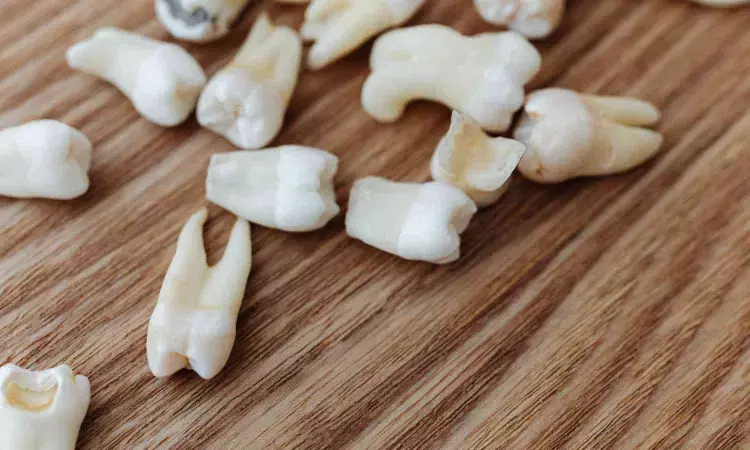- Home
- Medical news & Guidelines
- Anesthesiology
- Cardiology and CTVS
- Critical Care
- Dentistry
- Dermatology
- Diabetes and Endocrinology
- ENT
- Gastroenterology
- Medicine
- Nephrology
- Neurology
- Obstretics-Gynaecology
- Oncology
- Ophthalmology
- Orthopaedics
- Pediatrics-Neonatology
- Psychiatry
- Pulmonology
- Radiology
- Surgery
- Urology
- Laboratory Medicine
- Diet
- Nursing
- Paramedical
- Physiotherapy
- Health news
- Fact Check
- Bone Health Fact Check
- Brain Health Fact Check
- Cancer Related Fact Check
- Child Care Fact Check
- Dental and oral health fact check
- Diabetes and metabolic health fact check
- Diet and Nutrition Fact Check
- Eye and ENT Care Fact Check
- Fitness fact check
- Gut health fact check
- Heart health fact check
- Kidney health fact check
- Medical education fact check
- Men's health fact check
- Respiratory fact check
- Skin and hair care fact check
- Vaccine and Immunization fact check
- Women's health fact check
- AYUSH
- State News
- Andaman and Nicobar Islands
- Andhra Pradesh
- Arunachal Pradesh
- Assam
- Bihar
- Chandigarh
- Chattisgarh
- Dadra and Nagar Haveli
- Daman and Diu
- Delhi
- Goa
- Gujarat
- Haryana
- Himachal Pradesh
- Jammu & Kashmir
- Jharkhand
- Karnataka
- Kerala
- Ladakh
- Lakshadweep
- Madhya Pradesh
- Maharashtra
- Manipur
- Meghalaya
- Mizoram
- Nagaland
- Odisha
- Puducherry
- Punjab
- Rajasthan
- Sikkim
- Tamil Nadu
- Telangana
- Tripura
- Uttar Pradesh
- Uttrakhand
- West Bengal
- Medical Education
- Industry
Adenoid Hypertrophy Linked to Delayed Dental Development but Not Skeletal Growth in Children: Study

A new study published in the journal of BMC Oral Health showed that adenoid hypertrophy in children aged 7-12 does not significantly influence skeletal growth based on cervical vertebral maturation. However, it is associated with delayed dental development, as indicated by significantly lower Nolla dental age scores. This suggests impaired tooth eruption. Therefore a multidisciplinary approach involving pediatric dentists, orthodontists, ENT specialists, and pediatricians is recommended to manage the developmental effects of respiratory disorders effectively.
Long-term mouth breathing can result in narrow maxillary and mandibular dental arches, a retrognathic mandible, a steep mandibular plane angle, incompetent lips, and an increase in anterior face height. They are sometimes referred to as "adenoid facies" and are frequently seen in youngsters with tonsillar and/or adenoid hypertrophy. Using panoramic and lateral cephalometric radiographs, this study sought to retrospectively assess the impact of adenoid hypertrophy on dental age and growth development levels in pediatric patients ages 7 to 12.
This analytical-archival study assessed radiographs of 348 children aged 7–12 who had orthodontic assessment at a private oral and dental health polyclinic between 2008 and 2023. Using panoramic radiographs and the Nolla methods, dental ages were calculated. The WebcephTM software was used to analyse lateral cephalometric radiographs. The McNamara Method was used to measure adenoid hypertrophy, and the Baccetti Cervical Vertebral Maturation (CVM) stages were used to measure growth development levels.
Of the patients (n = 348), 29.8% had adenoid hypertrophy. The control group's SNA, ramus height, SNB, and face height ratio values were significantly higher (P < 0.05).
The study group had considerably higher values for FMA, mandibular plane angle, SN-GoMe, and Y-axis angle (P < 0.05). ANB, gonial angle, lower gonial angle, and convexity angle did not differ significantly (P > 0.05).
While there were no gender-based differences in CS2 and CS4 stages (P > 0.05), boys' chronological ages were considerably greater than girls' in CS1 and CS3 stages (P < 0.05). In both sexes, the Baccetti categorization stages rose with age, although the rate of rise was statistically higher for females (P<0.05).
Also, there were no discernible variations in the chronological ages of research groups within the same Baccetti phases (P > 0.05). The research group's Nolla ages were substantially lower (P < 0.05).
Overall, in children aged 7–12, adenoid hypertrophy had no discernible effect on growth and development levels as measured by cervical vertebral maturation. However, individuals with adenoid hypertrophy had substantially delayed Nolla dental ages, indicating a detrimental effect on tooth development and eruption.
Source:
Ahlat, E. M., Ertuğrul, F., Baydaş, B., Ersin, N., & Ghabchi, B. (2025). The effect of adenoid hypertrophy on growth-development level and dental maturation: a 15-year retrospective radiographs study. BMC Oral Health, 25(1), 1266. https://doi.org/10.1186/s12903-025-06600-3
Neuroscience Masters graduate
Jacinthlyn Sylvia, a Neuroscience Master's graduate from Chennai has worked extensively in deciphering the neurobiology of cognition and motor control in aging. She also has spread-out exposure to Neurosurgery from her Bachelor’s. She is currently involved in active Neuro-Oncology research. She is an upcoming neuroscientist with a fiery passion for writing. Her news cover at Medical Dialogues feature recent discoveries and updates from the healthcare and biomedical research fields. She can be reached at editorial@medicaldialogues.in
Dr Kamal Kant Kohli-MBBS, DTCD- a chest specialist with more than 30 years of practice and a flair for writing clinical articles, Dr Kamal Kant Kohli joined Medical Dialogues as a Chief Editor of Medical News. Besides writing articles, as an editor, he proofreads and verifies all the medical content published on Medical Dialogues including those coming from journals, studies,medical conferences,guidelines etc. Email: drkohli@medicaldialogues.in. Contact no. 011-43720751


